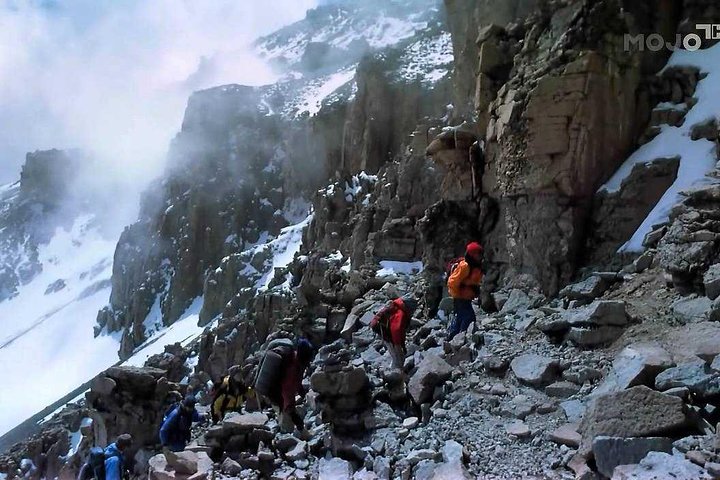Northern Circuit Route-Kilimanjaro’s Longest But Most Scenic
The Northern Circuit Route is Mt. Kilimanjaro’s longest route with exceptional scenery, comprising of lush rain forests, alpine meadows, barren deserts, & glaciated peaks
The Northern Circuit Route stands out as one of the most scenic, diverse, and least traveled route among Mount Kilimanjaro routes. Offering trekkers an extended journey around the northern slopes of the mountain, this route provides unparalleled opportunities to experience Kilimanjaro’s breathtaking landscapes and unique ecosystems.
This detailed guide delves into the Northern Circuit Route, highlighting its itinerary, benefits, challenges, and overall trekking experience.
Overview of the Northern Circuit Route
The Northern Circuit Route is renowned for its exceptional scenery, encompassing lush rainforests, alpine meadows, barren deserts, and glaciated peaks. It is the longest route on Kilimanjaro, circling around the northern slopes before joining the popular summit trails near the end. Trekkers embark on an approximately 90-kilometer (56-mile) journey that typically spans over 9 to 11 days, providing ample time for acclimatization and enjoyment of the surroundings.

Key Features
- Route Length: Approximately 90 kilometers (56 miles)
- Duration: Typically 9 to 11 days
- Difficulty: Moderate to high
- Success Rate: Around 90% for 9-day treks
8 Days Northern Circuit Route Detailed Itinerary
Day 1: Londorossi Gate to Mti Mkubwa (Big Tree Camp)
- Elevation: 2,360 meters (7,742 feet) to 2,820 meters (9,252 feet)
- Distance: 6 km (3.7 miles)
- Duration: 3-4 hours
The trek begins at Londorossi Gate, where registration and permits are processed. Trekkers then venture into the lush rainforest, ascending gradually to Mti Mkubwa, also known as Big Tree Camp, for their first night’s stay.
Day 2: Mti Mkubwa to Shira 1 Camp
- Elevation: 2,820 meters (9,252 feet) to 3,610 meters (11,843 feet)
- Distance: 8 km (5 miles)
- Duration: 5-6 hours
The route continues through the rainforest, eventually emerging onto the Shira Plateau. Trekkers are treated to panoramic views of the surrounding landscape as they make their way to Shira 1 Camp.
Day 3: Shira 1 Camp to Moir Hut
- Elevation: 3,610 meters (11,843 feet) to 4,200 meters (13,780 feet)
- Distance: 14 km (8.7 miles)
- Duration: 7-9 hours
The day’s journey takes trekkers across the expansive Shira Plateau towards the northeast. Passing through the high desert terrain, they arrive at Moir Hut, situated in a scenic valley with views of the Lent Hills and the Eastern Ice fields of Kilimanjaro.
Day 4: Moir Hut to Buffalo Camp
- Elevation: 4,200 meters (13,780 feet) to 4,020 meters (13,189 feet)
- Distance: 12 km (7.5 miles)
- Duration: 5-7 hours
The trek proceeds through rugged terrain, crossing several ridges and valleys. Trekkers may encounter wildlife such as buffalo and eland as they journey towards Buffalo Camp, nestled beneath the towering cliffs of the Northern Circuit.
Day 5: Buffalo Camp to Rongai Third Cave
- Elevation: 4,020 meters (13,189 feet) to 3,800 meters (12,467 feet)
- Distance: 8 km (5 miles)
- Duration: 5-6 hours
Descending into the Alpine Desert, trekkers continue towards Rongai Third Cave. The landscape becomes increasingly barren, offering striking views of the surrounding peaks and valleys.
Day 6: Rongai Third Cave to School Hut
- Elevation: 3,800 meters (12,467 feet) to 4,800 meters (15,748 feet)
- Distance: 15 km (9.3 miles)
- Duration: 7-9 hours
The route ascends steadily towards School Hut, the base camp for the summit attempt. Trekkers pass through barren alpine terrain, crossing the lunar-like landscape of the Saddle before reaching the campsite.
Day 7: School Hut to Uhuru Peak, then descent to Mweka Camp
- Elevation (Ascent): 4,800 meters (15,748 feet) to 5,895 meters (19,341 feet)
- Elevation (Descent): 5,895 meters (19,341 feet) to 3,100 meters (10,171 feet)
- Distance (Total): 21 km (13 miles)
- Duration: 12-15 hours
The summit push begins in the early hours of the morning, aiming to reach Uhuru Peak at sunrise. After celebrating at the summit, trekkers descend to Mweka Camp, where they spend their final night on the mountain.
Day 8: Mweka Camp to Mweka Gate
- Elevation: 3,100 meters (10,171 feet) to 1,640 meters (5,381 feet)
- Distance: 10 km (6.2 miles)
- Duration: 3-4 hours
The final descent leads through lush rainforest to Mweka Gate, where trekkers receive their certificates of achievement before departing for their accommodations.
Benefits of the Northern Circuit Route
- Scenic Beauty: The Northern Circuit Route offers stunning vistas of diverse landscapes, including rainforests, moorlands, deserts, and glaciers.
- Low Crowds: Due to its longer duration and remote starting point, the route sees fewer trekkers, providing a more peaceful and immersive experience.
- Effective Acclimatization: The extended itinerary allows for gradual altitude gain, increasing the chances of successful summit attempts and reducing the risk of altitude sickness.
- Wildlife Encounters: Trekkers may encounter a variety of wildlife, including buffalo, elephants, and monkeys, particularly in the rainforest sections of the route.
Challenges and Considerations
- Physical Demands: The Northern Circuit Route is physically demanding, requiring good fitness and stamina to navigate the long distances and high elevations.
- Variable Weather: Kilimanjaro’s weather can be unpredictable, with conditions ranging from hot and humid to freezing temperatures. Proper gear and clothing are essential.
- Altitude Sickness: Despite the gradual ascent profile, altitude sickness remains a risk. Trekkers should be vigilant and prepared to descend if necessary.